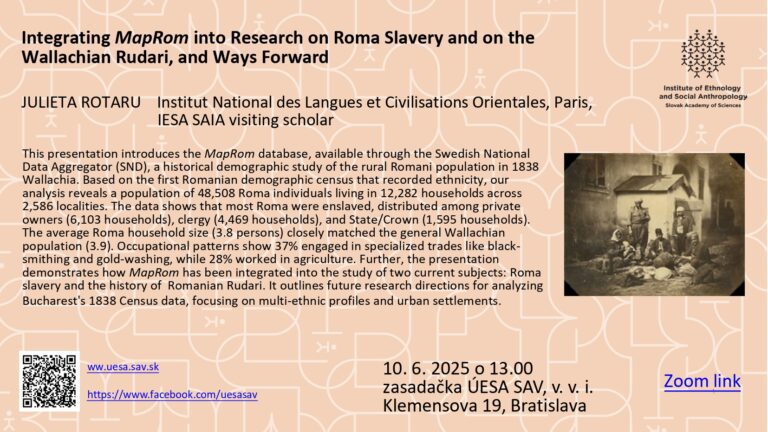Integrating MapRom into Research on Roma Slavery and on the Wallachian Rudari, and Ways Forward
- 10.6.2025
- о 13:00

On behalf of the Scientific Board of the Institute of Ethnology and Social Anthropology of the Slovak Academy of Sciences, you are cordially invited to a scholarly seminar featuring visiting scholar Julieta Rotaru (Institut National des Langues et Civilisations Orientales, Paris), who will deliver a presentation entitled Integrating MapRom into Research on Roma Slavery and on the Wallachian Rudari, and Ways Forward.
The seminar will take place on Tuesday, 10 June 2025, at 1:00 p.m. in the conference room of the Institute of Ethnology and Social Anthropology, SAS, located at Klemensova 19, Bratislava.
It will also be possible to join the event online via the following link HERE.
Anotation
This presentation introduces the MapRom database, available through the Swedish National Data Aggregator (SND), a historical demographic study of the rural Romani population in 1838 Wallachia. Based on the first Romanian demographic census that recorded ethnicity, our analysis reveals a population of 48,508 Roma individuals living in 12,282 households across 2,586 localities. The data shows that most Roma were enslaved, distributed among private owners (6,103 households), clergy (4,469 households), and State/Crown (1,595 households). The average Roma household size (3.8 persons) closely matched the general Wallachian population (3.9). Occupational patterns show 37% engaged in specialized trades like blacksmithing and gold-washing, while 28% worked in agriculture. Further, the presentation demonstrates how MapRom has been integrated into the study of two current subjects: Roma slavery and the history of Romanian Rudari. It outlines future research directions for analyzing Bucharest’s 1838 Census data, focusing on multi-ethnic profiles and urban settlements.